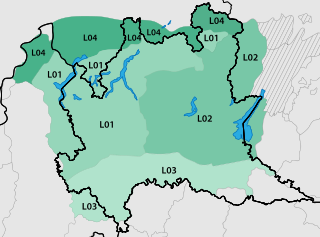
The Gallo-Romance branch of the Romance languages includes in the narrowest sense the langues d'oïl and Franco-Provençal. However, other definitions are far broader and variously encompass the Occitan or Occitano-Romance, Gallo-Italic or Rhaeto-Romance languages.
Milanese is the central variety of the Western dialect of the Lombard language spoken in Milan, the rest of its metropolitan city, and the northernmost part of the province of Pavia. Milanese, due to the importance of Milan, the largest city in Lombardy, is considered one of the most prestigious Lombard variants and the most prestigious one in the Western Lombard area.

Shtokavian or Štokavian is the prestige supradialect of the pluricentric Serbo-Croatian language and the basis of its Serbian, Croatian, Bosnian and Montenegrin standards. It is a part of the South Slavic dialect continuum. Its name comes from the form for the interrogative pronoun for "what" što. This is in contrast to Kajkavian and Chakavian.
The Ticinese dialect is the set of dialects, belonging to the Alpine and Western branch of the Lombard language, spoken in the northern part of the Canton of Ticino (Sopraceneri); the dialects of the region can generally vary from valley to valley, often even between single localities, while retaining the mutual intelligibility that is typical of the Lombard linguistic continuum.

The Gallo-Italic, Gallo-Italian, Gallo-Cisalpine or simply Cisalpine languages constitute the majority of the Romance languages of northern Italy: Piedmontese, Lombard, Emilian, Ligurian, and Romagnol. In central Italy they are spoken in the northern Marches ; in southern Italy in some language islands in Basilicata and Sicily.
Western Lombard is a group of dialects of Lombard, a Romance language spoken in Italy. It is widespread in the Lombard provinces of Milan, Monza, Varese, Como, Lecco, Sondrio, a small part of Cremona, Lodi and Pavia, and the Piedmont provinces of Novara, Verbano-Cusio-Ossola, the eastern part of the Province of Alessandria (Tortona), a small part of Vercelli (Valsesia), and Switzerland. After the name of the region involved, land of the former Duchy of Milan, this language is often referred to as Insubric or Milanese, or, after Clemente Merlo, Cisabduano.
Trøndersk, also known as trøndermål or trøndsk, is a Norwegian dialect, or rather a group of several sub-dialects. As is the case with all Norwegian dialects, it has no standardised orthography, and its users write either Bokmål or Nynorsk.
Brianzöö or Brianzoeu is a group of variants of the Western variety of the Lombard language, spoken in the region of Brianza.
Canzés is a variety of Brianzöö spoken in the commune of Canzo, Italy.
Eastern Lombard is a group of closely related variants of Lombard, a Gallo-Italic language spoken in Lombardy, mainly in the provinces of Bergamo, Brescia and Mantua, in the area around Cremona and in parts of Trentino. Its main variants are Bergamasque and Brescian.
Bustocco and Legnanese are two dialects of Western Lombard, spoken respectively in the cities of Busto Arsizio and Legnano, Lombardy.
The group of dialects Comasco-Lecchese is part of the Western Lombard language and is spoken in the province of Como and province of Lecco in Italy, especially around the capital cities and north of them. In other parts of this provinces, other Western Lombard varieties are spoken.
Novarese, locally pronounced Nuares, is a dialect of the Western Lombard language spoken in the province of Novara (Piedmont).

Cremonese (Cremunés) is a dialect of the Western Lombard dialect group spoken in the city and province of Cremona in Lombardy, Italy, with the exception of Crema and the area of Soresina, where an Eastern Lombard dialect is spoken, and the area of Casalmaggiore, where a form of Emilian closely related to Parmigiano is spoken.
Southwestern Lombard is a group of dialects of Western Lombard language spoken in the provinces of Pavia, Lodi, Novara, Cremona, in the south of the historic Insubria, and comprises Pavese, Ludesan, Novarese, Cremunés and others.
Lecchese is a dialect of Western Lombard language spoken in the city and suburbs of Lecco (Lombardy).
Comasco or Comasque is a dialect belonging to the Western branch of Lombard language, spoken in the city and suburbs of Como.
Pavese is a dialect of Western Lombard language spoken in province of Pavia (Lombardy). In Pavese, differently from most of Western Lombard dialects, the "z" is transformed into "s".
The Chepino dialect is a Bulgarian dialect of the Rhodopean group of the Rup dialects. Its range includes the northwestern Rhodopes, i.e. the towns of Velingrad, Rakitovo and Kostandovo and the villages of Dragichevo and Dorkovo. Its immediate neighbours are the Central Balkan dialect and the Ihtiman dialect to the north, the Babyak dialect to the west and south and the Hvoyna dialect to the east. The Chepino dialect is spoken by both Orthodox and Muslim Bulgarians in the region irrespective of religious affiliation.

The Matsu dialect is the local dialect of Matsu Islands, Taiwan. Native speakers also call it Bàng-huâ (平話), meaning the language spoken in everyday life. It is recognised as one of the statutory languages for public transport announcements in Lienchiang County, Taiwan.




